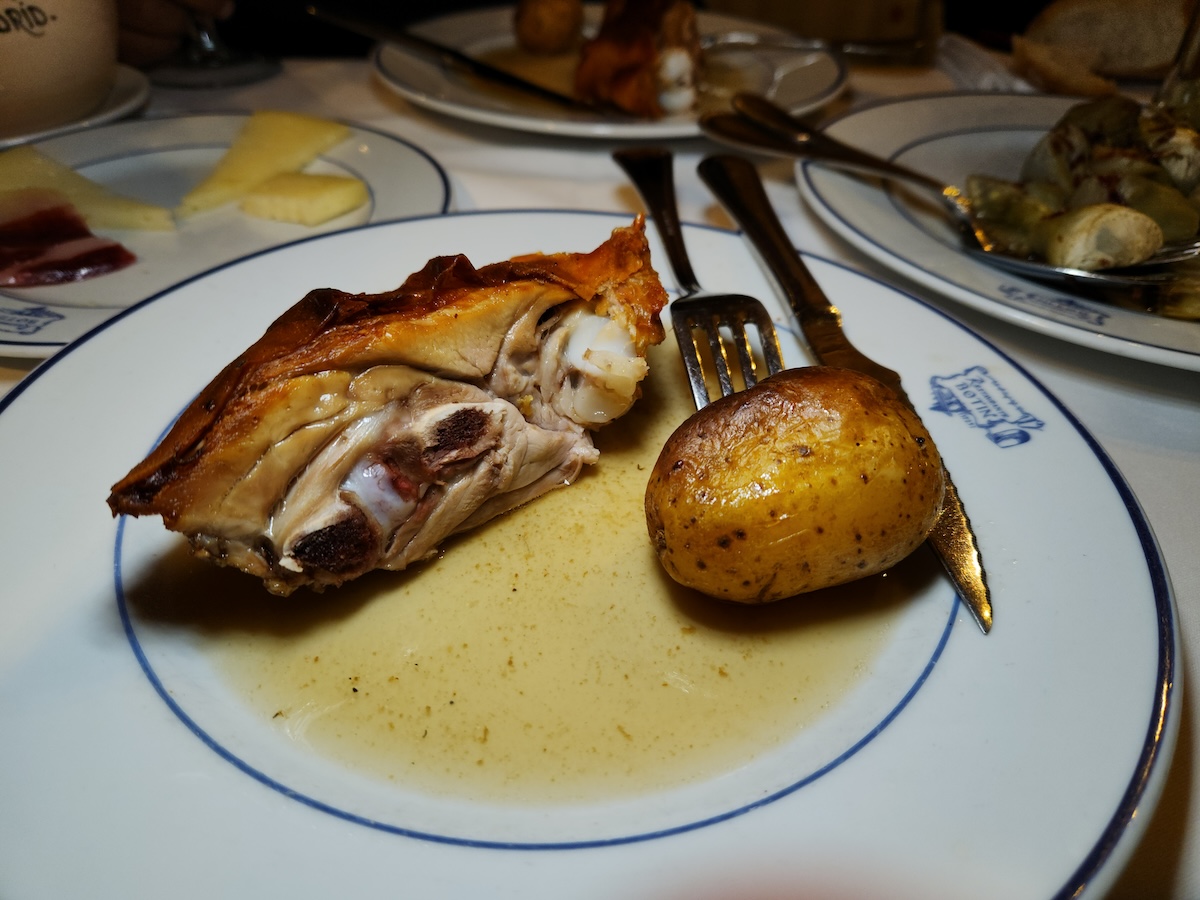99 years later, “The Sun Also Rises” is still delicious
Act 1: The Road to Hemingway’s Spain
Ernest Hemingway’s “The Sun Also Rises” begins in Paris but it doesn’t stay there. It follows a group of post-World War I expatriates, led by the emotionally distant narrator Jake Barnes and the captivating Lady Brett Ashley, with whom he shares a deep, impossible love. Their chaotic summer journey is joined by Brett’s fiancé, the troubled Mike Campbell, the charming but cynical Bill Gorton and the perpetually lost Robert Cohn, who is hopelessly infatuated with Brett.
The novel finds its messy center in Pamplona during the festival of San Fermín and the running of the bulls, a story of camaraderie, longing, and disillusionment. Beneath the clipped prose and bullfight bravado is a meditation on appetite, both emotional and physical. Food and drink mark the rhythm of the novel, from an early evening absinthe to trout beside the Irati River. What the characters eat reveals who they are, or who they wish they weren’t.
We begin our own journey in Bayonne, not Paris.
The city is rather overrun now than in the roaring 1920s, but the bones of Hemingway’s Europe remain if you know where to glance over coffee. “It’s the caffeine in it. Caffeine, we are here. Caffeine puts a man on her horse and a woman in his grave,” writes Jake Barnes. Coffee in the novel means moments of grounding, clarity, normalcy and lays a foundation for our day. Within view from where we enjoy a buttered baguette and sip our café au lait, the cathedral’s twin towers rise above the tiled roofs, and just beside us, tucked behind faded red shutters, is the ghost of the Hotel Panier Fleuri, where Jake stayed en route to Pamplona.
We stroll across the Pont Neuf, its international flags snapping in the morning breeze. The Nive and the Adour meet beneath our feet. It’s barely 10 a.m. and already the day promises heat. At the midpoint of the bridge, we hesitate. Ahead is the rest of France. Behind us, a story yet to be told. We turn back toward the car. Time to head to Spain.
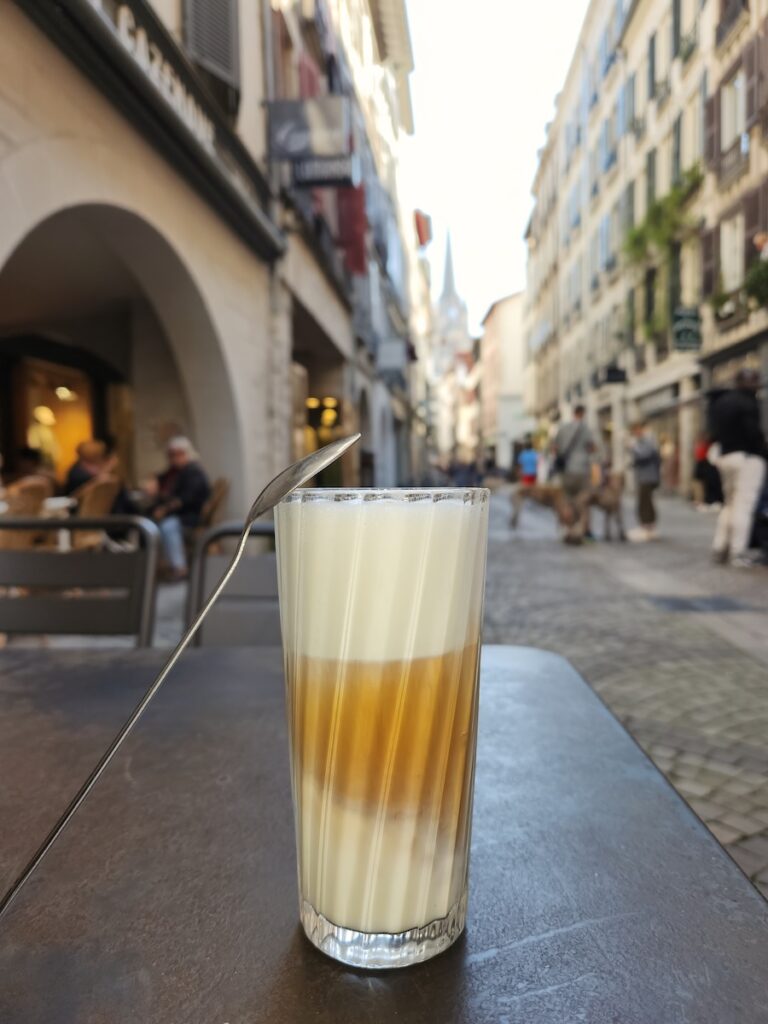
(Howie Southworth) Cafe au lait in Bayonne
It’s mid-morning and the car hums past the border and into Navarra. The road winds through the foothills like a prelude, each turn offering a sharper light and a deeper green. We stop to appreciate the color and a local omelet. Our first glimpse of Pamplona’s sandstone walls is a jolt. This city may be small, but in 1926 it became immortal, the place where a fiesta, thundering hooves, and a novel collided to shape modern legend.
We’ve come for the smaller festival, San Fermín Txikito, held each Fall to commemorate the saint’s original canonization, before the Summer celebrations stole Hemingway’s heart and the international spotlight. No bulls. No fireworks or colored kerchiefs just yet. Castillo Square is hushed, the anticipation almost audible.
Want more great food writing and recipes? Sign up for Salon’s free food newsletter, The Bite.
Jake and his friends stayed at the Hotel Montoya, a fictional stand-in for the long-gone Hotel Quintana, where Juanito Quintana, Hemingway’s friend and fellow bullfight aficionado, once welcomed the lost generation. But we check into the Hotel La Perla, Hemingway’s favored lodging for his later visits. Our room, his suite, overlooks Estafeta Street, the long stretch of the bull run that wakes the city during San Fermín. Realization, rest, then the hunger sets in.
We lunch late, even by Spanish standards, maybe it’s an early dinner. We walk past the Plaza de Toros. The ghost of young matador Pedro Romero, the quiet center of Jake’s storm, waits on the bullring sand. We cross the street and take our seats at El Burladero. A restaurant named for the protective wooden barrier in the ring, a place of strategy, escape. In “The Sun Also Rises,” Jake describes the first meal in Spain as a shock of “hors d’oeuvres, an egg course, two meat courses, vegetables, salad, and dessert and fruit. You have to drink plenty of wine to get it all down.” We do our best.
We begin with a gilda, a tiny skewer of anchovy, olive, pickled pepper and a platter of cured meats and cheeses. There are scrambled eggs with wild mushrooms, revuelto de hongos, followed by pisto, a tomato-and-eggplant stew on thick bread. We indulge in not one but two meats: carrilleras, stewed pork cheeks with red peppers, and perdiz escabechada, cold partridge preserved in vinegar and herbs with a crisp salad. We skip Robert Cohn’s plate of cold meats. For dessert, a slice of Basque cheesecake, no crust, just burnt sugar edges and silken center, served with fruit. Café con leche to finish. It’s lavish. It’s ritual. It’s the welcome Hemingway promised.
After dinner, we walk the narrow streets of the old town to Pamplona’s cathedral. The building is silent, the courtyard empty. In the novel, Jake often questions his Catholicism but still enters churches when the weight of the world catches up with him. “It was a grand religion, and I only wished I felt religious and maybe I would the next time,” he laments as his thoughts wander without aim and we can relate. The doors were heavy and carved and we push them open. It smells of incense inside and we light a candle. The motion is not absolution, but acknowledgment.
It’s lavish. It’s ritual. It’s the welcome Hemingway promised.
We step back out into the cool night, amble back to the center and take a seat in front of the arcade at Café Iruña. The square is quiet, no garlic wreaths, no romping crowd, no fiesta. Not yet. Just the clink of glasses and the shuffle of a waiter’s shoes. We order vermút and watch the lights in the windows of La Perla flicker on in time with the tall streetlamps above the plaza.
The next morning, We rise early for toast and marmalade and strong coffee at the same seat at Café Iruña, a nod to Jake and Bill’s breakfast at the hostal in Burguete. Then, we drive into the mountains to see it ourselves. On the road rising to the Pyrenees, we stop at a posada, a roadside inn where strings of chorizo and peppers hang like wind chimes above the bar. We drink cortados and observe the quiet trade of bread, wine, and words among Basque locals. This is the Spain Hemingway loved, humble, enduring, built for utility and warmth.
Farther on, through wooded curves and at the edge of the rise, Burguete. The town is shuttered. Its windows closed tight against the Autumn wind. We park and stroll past the inn where Jake and Bill stayed, the café closed for the afternoon. Then down the street, past the church, along the first legs of the Camino de Santiago. Among a dozen, we meet two pilgrims from the States, boots barely muddied, walking sticks barely warmed. We nod, exchange stories. They continue west.
We ponder the hours-long walk to the town of Aribe and Hemingway’s fishing spot along the Irati River. “That’s a hell of a hike,” we agree in our best Bill Gorton voice and choose the short drive instead. We park with a view of the village church steeple backed by steely limestone peaks of the Pyrenees and lunch at a bar some feet away. Smoked trout and white bean salad, a gesture to Jake’s hostel in Burguete whose open hours we missed.
Across the river on a span built by Romans and following the path through firs and beech, we soon reach a bend where the Irati turns back south. Where the old sanitorium stands watch above the river, overgrown, now only ghosts and damp stone. Where Hemingway’s characters fished for trout.
The water is low, but clear, lined with the shade of willows. We didn’t bring a rod. Just a notebook and ample time to sit on a rock and write. No bottles of wine cooling in the current, no talk of chickens or eggs or which one god invented first, no naps in the spots of sun. Only the peace that drew a contrast for Jake and Bill and Hemingway to what was to come back in Pamplona. Nothing but the song of birds and our own footsteps on the return to the car.
Ahead of our return to the city, we drive back up the ridge, back through Burguete, the inn still shuttered, and up to Roncesvalles, where the old monastery looms like a sentinel over the pass. The road cuts through a thick oak forest and opens briefly near a meadow where sturdy and patient Basque horses graze and pose for photos with passers-by, mostly Camino pilgrims. There’s a café just ahead of the monastery, there to serve armies of those on foot and on bikes.

(Howie Southworth ) Chistorra and pepper sandwich near Roncesvalles Monastery
We sit on the terrace and order a bocadillo, a sandwich of chistorra sausage and green local peppers, a memory of those hanging at the posada earlier in the day, now crisped on the griddle and folded simply into a toasted roll. Bill and Jake enjoyed a bottle of red or a few on this pass with this view at what we imagine was this café, but we have a drive ahead. Sparkling Pyrenees water is bright, cold, and good.
As we descend through Hemingway’s hills of escape from the madness of life, the mountains fade behind us. We return to Pamplona and the square as dusk greets us at La Perla. The city is stirring now. In a few hours, this small festival will not seem so small, fireworks, music, revelry, maybe garlic wreaths. Two tornados named Lady Brett Ashley and Robert Cohn loom. For now, a short rest. Tonight, the chaos.
Act II: The Fiesta
We never stood a chance. Not against the music, the wine, the crowd or the memory of Hemingway’s Pamplona, which surges through these streets even now. Jake Barnes’s July fiesta unfolded over seven days. Ours, in keeping with the condensed and frenzied logic of travel and literature, the San Fermín Txikito erupts in one wild final autumn night and bleeds into the next morning. We don’t mimic the tale of Jake’s not so merry band, not exactly, but its shape matches ours.
“The fiesta exploded. There is no other way to describe it,” writes Hemingway in Jake’s voice, but here and now, it’s more of a hum slowly reaching its crescendo. The square is already abuzz. It’s just after sunset, and the smaller, local San Fermín Txikito is about to reach its heights. No bulls run. No gored tourists. No Robert Cohn or his green-eyed monster. But it’s still Pamplona, still a fiesta, still a hell of a ride. Of his novel’s effect on the town during the July festival, Hemingway once wrote, “It is all there as it always was except forty thousand tourists have been added.” Tonight, they’re gone. This is intimate exuberance and feels closer to his “goddamnedest wild time.”
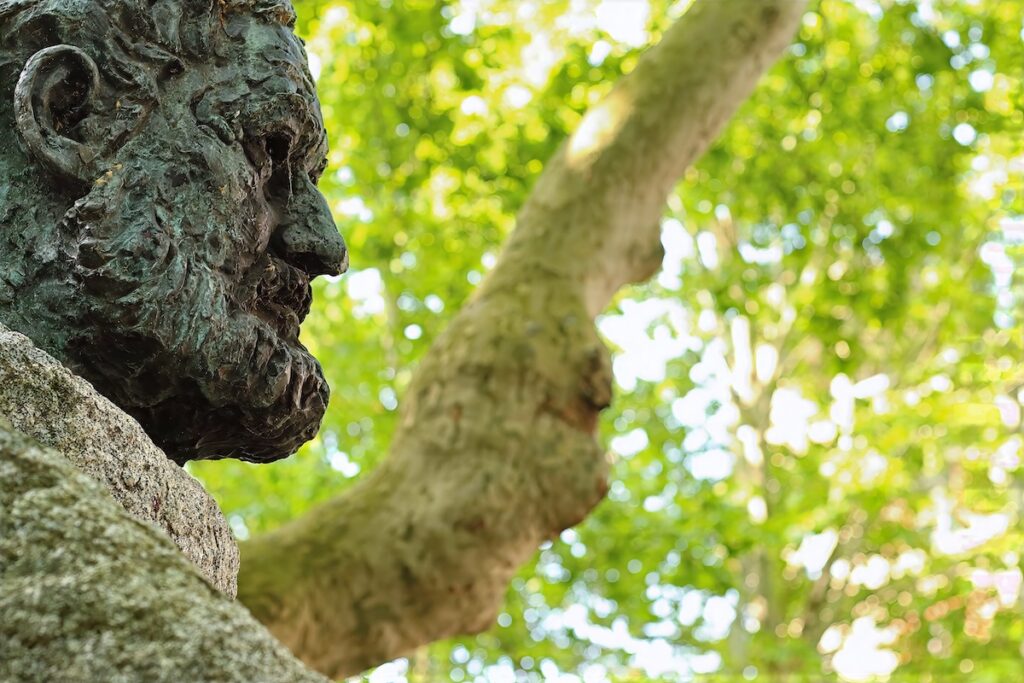
(Howie Southworth ) Hemingway statue near the bullring in Pamplona
We begin with a green fairy under the colonnade. “The absinthe made everything seem better,” Jake says as the last night of the party begins in The Sun Also Rises. We raise our glasses with a wry smile, like his, and let the warm burn signal the start. A brass band cracks the calm, something between ska and Basque tradition, loud and local. Trombones bleat, a tuba bellows, drums are the heart. The band leads an impromptu parade through the arches, and we are caught. We march too, clapping, bopping, dodging those not yet caught and puddles of the sudden rain and spilled gin. We are already sweating.
We break from the pack, duck down San Nicolás Street, and find Restaurante Baserriberri. We hear the chef has a trio of thematic plates for us and we’re curious. An early dinner for Spain, but sustenance just enough to fortify before the night carries on. Chef Iñaki Andradas cooks like a man born too late to fight bulls but too inventive not to try something just as daring. First, the bOOmVeja tapa, only here in Basque country, they’re called pintxos. It arrives smoking, dramatic, and served in a hollowed bomb shell. A tribute to Jake Barnes’s unfortunate war injury. Inside the shell as the smoke clears is stewed lamb over a cream-filled Japanese pancake.
Next, a little deep-fried quail leg, crisp and savory, like a miniature Southern Colonel’s specialty or Bill Gorton’s riverside treat, paired with a sharp aioli. Then a “hot dog,” local chistorra, red with spice and crisped, tucked in a brioche bun and loaded Chicago-style, plated in a cardboard bull. It’s theatrical and ridiculous and the only bull we’ll see tonight. We sip a glass of Crianza and talk with GM Javier, who praises Chef Iñaki’s approach. “Contemporary, but not molecular,” he tells us. “Flavors first, then fun.” In the novel, Jake laments “the first meal of prices being doubled for the fiesta,” and here we’re glad to pay.
Outside, the band marches on along the borders of the square and we rejoin to work up to the next meal, gin tonics now in hand. We don’t know where we’re going, but neither did Jake and Bill and Brett and Mike. Not really. They followed noise, hospitality, and instinct and casually kept tabs on a drunk Cohn, and we follow suit.
Bars beckon along our path of modern-day “riau-riau music, the pipes shrill and the drums pounding,” and we dance our way in and out of a few joints, looking for the right madness. We try a tight corner off the square, a bodega with hanging leather wineskins and plenty of barrels, and finally win a spot at the small counter. On the bar, mojama con cebollas encurtidas, salt-cured tuna with pickled onions. Hemingway never writes of mojama, but Mike Campbell shared tuna and onions and oil and vinegar with the band of dancers who adopted them along the festival’s path. This ruby-red ham of the sea counts and we share with new friends and toast the night. Our toasts from glasses, not wineskins, which we try to solve.
Like Jake before us, we step out of the bodega to find a shop that sells wine botas. We get as far as the church of San Nicolás. Church doors are open, but not for us tonight. We ask an older woman. “Las Tres ZZZ moved out of the center years ago,” she says of Hemingway’s favorite brand and we vow to find them later. For now, more music if we can track down Gazte Txaranga, the band from before. Just follow the sounds and wide smiles, we think.
We never stood a chance. Not against the music, the wine, the crowd or the memory of Hemingway’s Pamplona, which surges through these streets even now.
Once outside, we catch a glimpse of tapping heels ducking down a blind alley and it looks like the back of our crowd. Rain again threatens and a sheltered corridor becomes an impromptu disco for two-hundred die-hards. That’s all that fits and we make the cut. “All you saw was the heads and shoulders going up and down, up and down,” as Jake would observe. We dance away from the weather, toe-to-toe with strangers, as cups get drained and refilled by now-roving bottles. The ground slick with overflowing delight instead of rain. We’re all ridiculous and glorious and now tired. The music fades and we, the hangers-on, disperse.
Hunger strikes and we think of the appeal of pintxos. Too small to overwhelm and there’s always room for more. Maybe a walk first to stay fresh.
We stretch beyond the cathedral and onto Pamplona’s city walls, where the stone holds centuries of sieges, prayers, and heartbreak. “Across the plain it was dark, and we could see lights on the mountains,” writes Jake. Here we talk of impossible love, of passion and jealousy, of loss and the practical cruelties that make desire without relief. It is Brett and Jake’s dilemma distilled, her hunger for love, his incapacity, their knowing futility. Brett’s lust for the young matador Romero simmered. He would complicate it all.
Somewhere earlier and prescient, Jake admits, “You can’t get away from yourself by moving from one place to another.” The line fits here, at the edge of town, where escape feels close yet never arrives. The silence of the walls, the weight of their history, presses on our words until they, too, are pared down to essentials.
We step off the wall as the tentative rain finally makes a commitment. We wander back wet, down to Castillo Square, down to the ghosts of Bar Milano, a stand-in for Bar Torino, and Café Suizo, where the fiesta unravels in insults, a love polygon and fisticuffs. Hemingway wrote it as the night when everything collapsed. Jake sends Brett off with the bullfighter Romero. Mike gets jealous and drunk. Cohn gets jealous and violent. “It is awfully easy to be hard-boiled about everything in the daytime,” Jake writes, “but at night it is another thing.” Perhaps better that the places where it all happened are long-shuttered.
Jake describes Bar Milano as “a small, tough bar where you could get food.” This may be the case with many bars here, but we head to the best food and not so “tough.” Bar Gaucho, Pamplona’s most famous temple of pintxos. Though it opened well after Hemingway’s time, he would admire the bar’s seamless operation, the dishes emerging with military precision on a cramped night like this. Cold pintxos on the bar for the taking, hot pintxos appearing like clockwork from the tiny but powerful kitchen.
We meet Iñaki, the manager here who is appropriately more matador than barkeep. He leads his crew not of banderilleros and picadors, but of drink crafters and cooks through flawless passes to a demanding mob, his “domination of the bull.” He calls his pintxos “the best of Basque cuisine, only tiny.” And we agree.
We order Iñaki’s finest dishes, pintxo de anguila, roasted eel set atop a tomato gel and a sliver of white toasted bread. Elegant and delicious, and persuasive for those afraid of eel. Next, a showstopper, the dish that disappears as quickly as it appears on the pintxo bar is their huevo trufado, the truffled egg. A glass filled with black truffle cream in which a perfectly soft-cooked egg rests, topped with crisp French fries and dust of jamón. A dish Hemingway couldn’t have imagined when he wrote “eat an egg.” The barkeep pours small glasses of Fundador brandy as a nod to our project, the fuel that fed peak drama at Milano and Suizo.
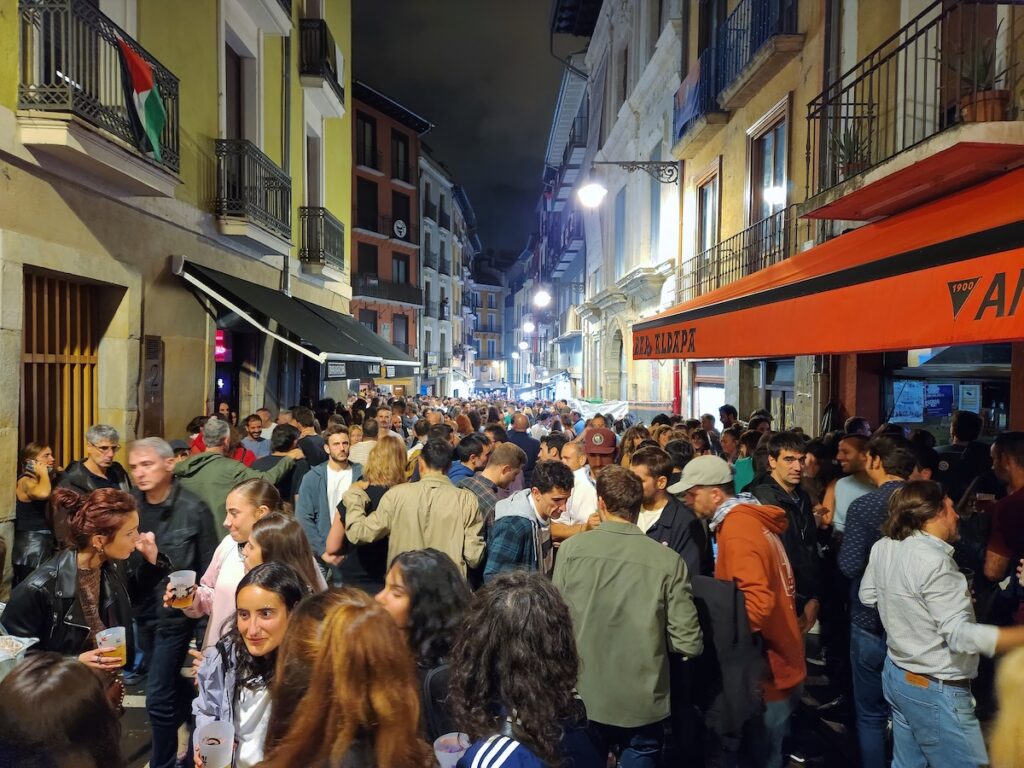
(Howie Southworth ) San Fermín Txikito crowd
As we wander back across the square and into the maze of old town streets, the festival is in full swing. Lanes are rivers of people, laughter and music spilling from every corner. At the confluence of three alleyways, the crowd swells, a living, breathing thing. We meet three strangers-turned-friends here, likely by stepping on a foot or three: José, Mikel, and yet another Iñaki. They greet us with warmth, embracing us as the only foreigners in sight. Our Spanish is like their English, sparse, but effective. They, like many others in this sea of humanity, are here to reunite with old friends, the ones they see but once each year during the Txikito. And now us.
The trio takes us in, guiding us through the mass of revelers. We talk of Hemingway, of Spain, of Basque pride, and of food. After an hour, they disappear into a crowded bar, but we had our fun. Then, they emerge triumphantly with a round for us all. As a gesture of true camaraderie, they grin and untie their own blue pañuelos and tie these kerchiefs around our necks. “Now you’re in our peña,” Mikel says. Jake’s crew never earned a scarf. They partied among the peñas, but never of them. Ninety-nine years later, we are tied in.
Events stretch on, the rain long forgotten, the music and laughter our bosom companions. Eventually, we find ourselves back in the square, watching the lights and merrymakers dance on the wet stones. The festival feels timeless, unhurried, alive in a way that the modern San Fermín cannot be. It is a smaller celebration, yes, but no less significant. A festival unspoiled by spectacle and overflowing with soul. We feel it and Hemingway and his cast of misanthropes would be home.
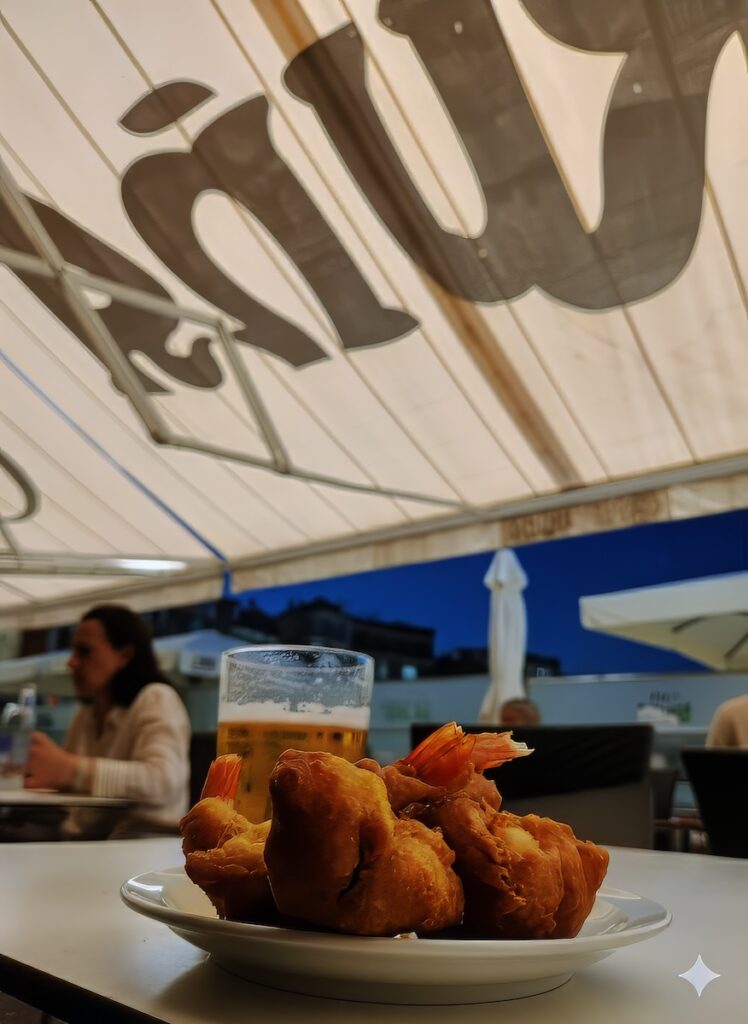
(Howie Southworth) Fried shrimp at Café Iruña in Pamplona
The night doesn’t end. It just softens. Somewhere half past exhaustion, we stagger back to Café Iruña. Hemingway’s and Jake’s favorite haunt. Ours too. It’s quiet now, but the fryers are still on and reflection is on the menu. We order fried shrimp and cold beers and remember that Jake in the end liked Robert Cohn. As do we, tragic. Here, No fights break out. No tables are tipped over. Our shrimp are safe. For a moment.
At the end of their longest night, Jake writes, “I do not know what time I got to bed.” We’re with you, Mr. Barnes. Back at our suite, we leave the balcony doors open to Estafeta Street for the cool post-rain air, that freshly clean smell that cannot be replaced and the joyful noise fading over time. If only to keep living it the best we can, but far too burnt to party in earnest into the wee hours. Our blue scarves hang from a chair, limp with gravity. The sounds of this life happening and this breeze are enough, and even Jake Barnes and crew would approve of our calling it a night. Tomorrow, recovery.
Act III: Leaving Pamplona
“In the morning it was all over. The fiesta was finished.” Jake’s words hadn’t rung louder, like these damned church bells. First light beams through the curtains and doors we left open to the balcony and confirm our well-earned sleep is over. A chill had moved into the room, slowly replacing the bluster of revelers over the wee hours. Now there is silence, no shouts or clinking or songs or even whispers to break the quiet. A few distant screeches of brooms on cobblestone, that’s all. We stand on the balcony over Estafeta street taking it all in. This was Hemingway’s favorite perch for the running of the bulls, above the fray. Some say he never ran it. A few of his mended ribs beg to differ.
We hit refresh, shower, toss on clothes and head down the stairs and into the streets, eager to witness the aftermath of San Fermín Txikito at ground-level. One hundred feet into the square, Café Iruña’s terrace and vapors of freshly brewed coffee beckon. After a night like last night, we stick to strong coffee. That hits the spot. To repeat, “It’s the caffeine in it. Caffeine, we are here.” Iruña feels relaxed, as if exhaling after the madness of the past hours.
Outside the terrace, the square is immaculate. Not an ounce of litter, no errant barware lost with the throngs, no drunk soldiers left behind. The city has successfully deleted the night before, scrubbed it clean with unseen hands. The breeze carries no aroma of red wine or rain-soaked ska bands. It’s almost as if the fiesta never occurred, but we catch a glimpse of the blue and white neckerchief of one clan or another tied to a column of the gazebo. It wasn’t all a dream.

(Howie Southworth ) Clean streets after the fiesta in Pamplona
We pay our small tab and walk on toward the end of town. As we round the corner out of the municipal plaza, those same green hills that called us to the countryside appear just beyond the end of the road. A corral sits on the right, this is where the bulls begin their ill-fated run. The fences hold no bulls today, the streets, no runners. But there looks to be one last parade. A troupe of musicians and dancers collects just outside the corral, its members clad in the whites and red of Basque tradition.
Flutes and drums tune up as spectators begin to line the curbs and balconies along the street. The desolate morning we had first walked into suddenly blossoms into a different type of festive crowd. “There’s no more wine in our veins, just cold coffee and the sound of flutes,” writes Jake and it feels good. The music and marching begin in earnest, the dancers gesture and move in unison with wooden swords. We’re drawn into the procession marking the true closing ceremony of the Txikito.
Just as the parade reaches City Hall, another parade is on a slow-motion collision course with our own. “Great giants… thirty feet high” and big-headed protectors, the kilikis and zaldikos. The giants spin and bob along the route, their long skirts whirling over the crowd. Children giggle and run as kilikis with soft foam truncheons bop them if they get too close. We run and laugh with the kids and also take a few hits and learn our lesson. This is Pamplona without the need for bulls and a triage nurse, a kinder tradition that precedes Hemingway by a century, one he saw as pure joy.
The now-merged parades funnel up the hill toward the cathedral. We stick it out until what seems like the religious end and then slip away. San Sebastián calls to us as it did Jake to put a bookend on his own fiesta. To rest, to breathe, to eat near his beloved sea. Maybe a swim if these clouds give us a break. For now, we have one more Pamplona thing to do.
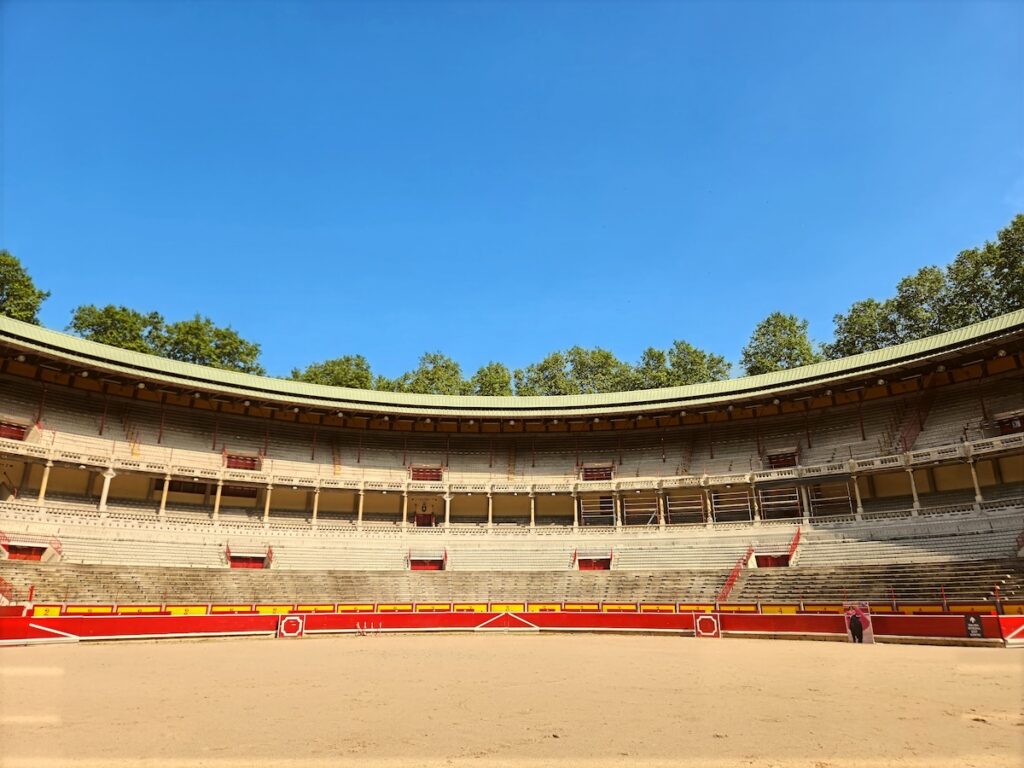
(Howie Southworth ) The Pamplona bullring, empty
At a bar called Viva San Fermín, we buy a rabo de toro sandwich, braised oxtail on crusty bread, and carry it to the bullring. We take the tour and linger and sit in the sunlit seats above the sand. We eat in silence. Sacrifice hangs in the air. Robert Cohn once says, “Nobody ever lives their life all the way up except bullfighters.” Cohn, this toast is for the bulls. We chew slowly.
On our way out of town, we detour to the Las Tres ZZZ wineskin factory, just outside the center. Though almost a century has passed, Jake had it right. “Inside it smelled of fresh tanned leather and hot tar. A man was stencilling completed wineskins. They hung from the roof in bunches. He took one down, blew it up, screwed the nozzle tight, and then jumped on it.” With the pleasure of having an exact moment from the novel, we bid goodbye to Pamplona and hop a train.
We retreat to San Sebastián like Jake Barnes before us. The train delivering us from the hangover of Pamplona into the arms of Donostia, where the sea breathes more slowly. “Even on a hot day,” Jake writes, “San Sebastián “has a certain early-morning quality.” And that’s how it greets us now, crisp light over washed stone streets, air sweetened by sea spray. A city of recovery.
We check into the Hotel Londres, Hemingway’s hotel, a corner room with a side view of La Concha and a ceiling fan that stirs the salt in the air. Hunger has caught up with us. We cross to the harbor and settle in at a terrace overlooking the boats and the bay, asking little of the menu but for one essential dish. Merluza en salsa verde. A Basque standard. Flaky hake-fish in a light, briny parsley sauce and an emulsion of olive oil, on a bed of smashed potatoes. Crowned with crispy lardons. It’s subtle, restorative, simple, like Jake would have wanted. Needed. To drink, a glass of Rioja, a damn fine wine. For dessert, a stroll.
We walk through the old quarter and onto the promenade above Hemingway’s beloved La Concha beach. With a towel and swimsuit in tow we open Jake Barnes’s playbook, rent a locker, and change. La Concha is usually a smooth bay protected by the green hill of Santa Clara Island. Today, it’s rougher, the waves higher. As Jake reported before us, “They came in like undulations in the water, gathered weight of water, and then broke smoothly on the warm sand,” and warm it was. The water however is bracing on first touch, just a toe, but we then dive in whole.

(Howie Southworth) La Concha Beach in San Sebastián
We wade out then float farther into the surf, our progress dented a little with each passing roller. Once fully committed, the cold is comfortable, and the blue sky helps. Kids leap and slide from the floating docks, their sounds of delight travel across the surface. Yachts sail in, fishing boats sail out, and we get a few jumps off the docks ourselves. The sea cleanses.
The sun now focused on our swim, the sea warms around us and so we linger, dive longer and deeper, letting the current sway us to the opposite end of the bay. As we walk the long beach on toasty sand toward the lockers, the sun dries us and leaves us salty.
After a quick shower and change, we follow Jake’s lead back into the old town, “then up one of the cool streets to the Café Marinas. There was an orchestra playing inside the café.” Only it is now a jewelry shop, there’s no orchestra. As luck has it, there is a gelato joint next door and so we continue his lead, sit on the terrace, people-watch and while away and enjoy lemon sorbet. We skip Jake’s “long whiskey and soda.” An early train to Madrid in the morning sends us to bed without dinner.
Early AM. We enjoy the view of La Concha one last time before boarding the train to Madrid. The rhythm of the rails is a tonic, and we nap. Hard, waking just before the Atocha station to enjoy a jamón sandwich with grated tomato and olive oil as a smear. The capital greets us not with wild crowds, but with shadowed buildings and the whir of taxis along San Jerónimo Street.
We ask the taxi to go the long way and pass the Hostal Aguilar, the novel’s Hotel Montana. Where Brett Ashley shacked up with bullfighter Pedro Romero until she booted him to the curb and Jake swept in as he tended to for Brett. We nod in Romero’s direction and descend toward the golden glow of The Westin Palace for martinis in the footsteps of Jake and a newly matador-free Brett.
As Hemingway exclaimed in the voice of Jake Barnes, “It’s funny what a wonderful gentility you get in the bar of a big hotel.” As Jake and Lady Brett may agree, The Palace certainly fit the bill. Our barkeep is pleasantly chatty. The room is opulent, the patrons sharp, and the stools oddly comfortable for stools. The barkeep turns to artist as he shakes our martinis frosty and pours. That first sip of cold, sharp gin and the illusion of vermouth cuts through our train ride haze. No nonsense, a tap of the power switch.
Now awake and aware of the need to eat, we walk the old stone to Sobrino de Botín, “It is one of the best restaurants in the world,” according to Hemingway, who immortalized the place. Jake and Brett dined upstairs. We go below, into the cave where the walls lean in like old companions. We’re prescribed to order cochinillo asado, the roasted suckling pig in the book, and sopa de ajo, garlic soup just for fun.
The pork arrives garnished with buttery potatoes. The skin is crisp, and the meat is tender, barely holding onto the bone. There is nothing nuanced about this dish. Fire, salt, olive oil, a branch of thyme or rosemary thrown in for aroma. Hemingway enjoyed foods for what they were, and this was that. Botín and the 18th-century wood oven have endured on this very philosophy. It’s primal.
Want more great food writing and recipes? Sign up for Salon’s free food newsletter, The Bite.
Though a fork and knife make one feel civilized while digging into the roast, this ruby glass of Rioja Alta doesn’t hurt. Its oaky, sharp, clean character cuts through the lush bites of pork perfectly. Hemingway, always particular about his wine, held Rioja Alta at the top. It played nicely with the robust flavors of Spanish cooking. This pure and balanced duet of meat and drink echoes Hemingway’s sentiment that food isn’t mere sustenance. It’s culture and it’s a way to connect. In this restaurant with aging walls, deep roots, and possible ghosts, this bite and this sip in this moment is Spain.
Then, the table gets more crowded. Garlic soup. Rich broth thickened with bread, dusted with paprika, spiked with bits of cured ham, with a poached egg to mix in. Hemingway wrote of long braided strands of garlic around the necks of San Fermín revelers. They say it wards off evil spirits. And that may or may not be true, but why take chances.
We step out of Botín into the Madrid sun, full of garlic and pig, Rioja and memory. Jake and Brett ended here too, in a taxi that wound up the Gran Vía. “Oh, Jake, we could have had such a damned good time together,” she tells him. And he answers, “Isn’t it pretty to think so?” Their love, impossible. Their appetite, insatiable. Their story, unfinished.
We don’t hail a taxi. Instead, we walk. Through Hemingway’s beloved Centro district over to Gran Via for one last look, the neon and marble, the noise of traffic and midday tipplers. The city feels endless and awake. We sit on a bench and let it wash over us, wondering what ghosts of the lost generation would make of this, our Spain. The air is thick with possibility, with futility, with the truth that some hunger is never fed.
Read more
about Spanish food

